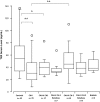Measurement of serum tenascin-X in patients with congenital adrenal hyperplasia at risk for Ehlers-Danlos contiguous gene deletion syndrome CAH-X
- PMID: 31666125
- PMCID: PMC6820911
- DOI: 10.1186/s13104-019-4753-7
Measurement of serum tenascin-X in patients with congenital adrenal hyperplasia at risk for Ehlers-Danlos contiguous gene deletion syndrome CAH-X
Abstract
Objective: Approximately 10% of patients with congenital adrenal hyperplasia (CAH) due to 21-hydroxylase deficiency carry a mutation that disrupts CYP21A2 and the flanking TNXB gene resulting in CAH-X, a contiguous gene deletion syndrome. TNXB encodes tenascin-X (TNX), an extracellular matrix glycoprotein that plays an important role in collagen organization. TNXB impairment is associated with Ehlers-Danlos syndrome. Symptoms include joint hypermobility, hernias and cardiac defects. We measured serum TNX using an antibody targeting the amino-terminal of the TNX protein in 161 subjects, including extensively genotyped and phenotyped CAH patients, their relatives, and healthy controls.
Results: We evaluated the potential of serum TNX as a screening tool for CAH-X. CAH-X patients, especially haploinsufficient patients carrying the TNXA-TNXB chimeric gene CAH-X-CH-1 showed reduced TNX levels compared to controls (P < 0.05). TNX levels were similar in all subjects carrying a TNXB mutation. However, CAH patients who did not harbor a TNXB mutation also had reduced TNX compared to controls (P < 0.001). Thus, measuring serum TNX is not an effective screen for CAH-X amongst patients with CAH. TNXB genotyping is recommended for CAH patients who have symptoms of a connective tissue disorder. Epigenetic factors that influence TNX expression require further study.
Keywords: CYP21A2; Congenital adrenal hyperplasia; Ehlers–Danlos syndrome; TNXB; Tenascin-X.
Conflict of interest statement
The authors declare that they have no competing interests.
Figures


References
MeSH terms
Substances
Supplementary concepts
LinkOut - more resources
Full Text Sources
Medical
Miscellaneous

